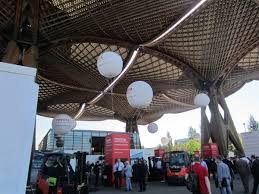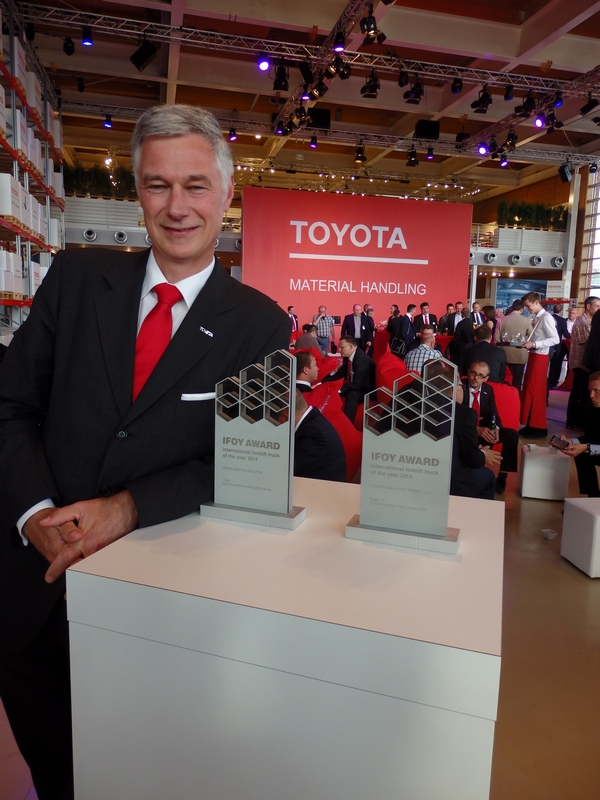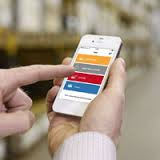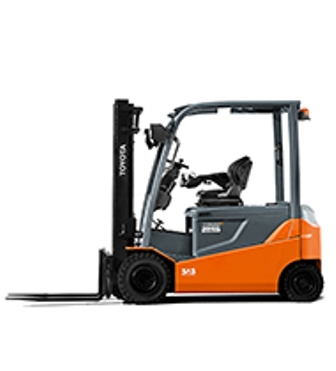 Pavillion 32 -Toyota Material Handling Europe at CeMAT 2014 |
Forkliftaction.com News' Melissa Barnett caught up with Matthias Fischer, CEO and president of Toyota Material Handling Europe, at the recent CeMAT gathering in Hannover.
MB: Is the refurbished or used forklift market an area Toyota is expanding into?
MF: Yes, it is an area we are expanding because the second-hand market is a huge market, particularly for counterbalance forklifts. The Toyota product is known for its high quality and this is the same for the used forklifts. We source our used forklifts from Europe, because it keeps transport costs down. The used forklifts are mainly generated from Toyota's rental fleets and also from our short-term rentals. We replace the short- term rental fleets with new forklifts after two or three years so they don't become too old.
MB: A number of forklift OEMs are now expanding into the used equipment market. Is your move a response to falling sales during the GFC in the new forklifts sector?
MF: I think there are smaller customers who only use the machine twice or five times a day who would like to have a high-quality product but they don't want to spend so much money for a new one. Especially for used equipment which has a full warranty with it - for these customers there is not much difference from a new machine. These are traditional used forklift buyers.
What we did in the past was we sold the used equipment to traders and they were selling them into the second-hand market. We have changed the strategy to sell directly to our customers because afterwards we would like to have the service and maintenance business of Toyota forklifts secured.
MB: Is there any conflict between Toyota's new and used sales sectors?
MF: No, it is more the other way around - a lot of customers during the time they are growing buy used forklifts. Then, when they reach a certain size, they buy new forklifts. They may start with just one or two new forklifts, then grow from there. We try to grow with the customer and to start a happy relationship very early. This is the other trend and one of the reasons we are selling used forklifts.
 Matthias Fischer, CEO and president of TMHE, with Toyota's IFOY awards |
MB: Congratulations on your IFOY (international forklift of the year) awards. Can you tell me about the winning products?
MF: We are quite proud of them. We had two trucks in the counterbalance up to 3.5 T (category)and we were the only ones with forklifts in this category but we didn't know which forklift would win - it could have been either the Traigo 80, electric counterbalance forklift or our hydrostatic transmission forklift, but we didn't know which one. It was the Traigo 80 that won.There isn't any competition between the sales or the R&D teams for the two forklifts. The R&D team is the same for both forklifts. The award is completely in line with our commitment to reduce fuel emissions and to bringing energy costs down.
MB: And what about your second IFOY winning product: can you tell me about it?
MF: We were really happy about the second award because we had no idea who would win. We are very impressed to have won the best intralogistics solution with I_Site. It is the third generation of I_Site - development is always quite fast with this sort of technology. The great thing about I_Site now is that it is not only monitoring your forklift, it analyses the efficiency of your truck, looking into health and safety as well, having the pre-check for the driver before he starts it. We have now built in a lot of things to make the operation a lot safer. We can now benchmark things like equipment shocks and analyse why they might be happening - for example, is the operating area too small, is it the way the driver is driving? We keep in very close contact with the customer and if the customer allows us to see the data, then we can help in analysis and discuss how we can make the operation safer, more efficient and cheaper as well. What we have analysed is that if you have an accident, what customers measure is only the damage to the forklift, which may be EUR1,000, but the real cost (may be) up to 10 times higher because you may have damaged goods, damaged racking, maybe injury. To bring this awareness to the customer is, I think, of very high value.
 Toyota I_Site |
MB: Is I_Site standard on all Toyota forklifts?
MF: No, it is an option. The buyer has to decide whether he wants the I_Site fitted. We are finding more customers are thinking I_Site is a good tool and, therefore, having it fitted. Earlier versions of I_Site are fitted to some of the second-hand forklifts and the new generation I_Site can also be fitted to used forklifts. What we are finding is that a lot of customers who are buying new fleets of forklifts are having the I_Site technology fitted, but are also wanting their existing forklifts fitted with I_Site technology, retrospectively. What we have to do is convince the customer of the value of the technology and then of the data analysis - that it will save them money in the long run. Initial investment is between EUR300-EUR500 - not a big investment, about the same as a mobile phone, and then you have the data costs on top of that.
MB: How has CeMAT 2014 been for TMHE? Are you enjoying being outside under the pavilion?
MF: It has been very good for us, especially now we are under the nice pavilion. This is the first time we have had the chance to be under this booth here - it was nice of our competitors to give us this space, but seriously, the good thing is now we are in line with our major competitors in Europe. The size of the space has doubled from what we had in the hall, but the cost is almost the same because a lot of the equipment which is already here we can use, so it is much more efficient for us. It is much more attractive for the customers as well. We have had good feedback from customers. It is open and is like an invitation to customers to come in. We have measured the number of leads that we've had compared to three years ago and it has more than doubled and I think that has a lot to do with the place we are now - pavilion 32. We have booked the space for the next CeMAT also.
MB: What do you think of Deutsche Messe's decision to stage the CeMAT event every two years again, rather than keep it at three?
MF: We have to live with it, I suppose, but we also have to think about the cost of every two years. I have heard from smaller and mid-sized companies that they have questioned whether they can cover the costs of a two-year CeMAT cycle. Even we are looking at our cost structures for such an event. We will know closer to the next CeMAT how the flow of prospects and customers is - whether they are more or the same. Also, it will be a shorter time, from Tuesday to Friday, four days - our busiest days are Tuesday to Thursday - I wonder if Tuesday in the short week will be as attractive as Tuesday is now because, if it is not, then we will only have two main days. It will be interesting to see what happens. I think it might be a discussion for the industry. I still believe that CeMAT is a good fair and so we will be here in two years' time.
 Toyota Traigo 80 |
MB: What is TMHE's reason for coming to CeMAT? Is it to launch new products, see customers or something else?
MF: We do not really use CeMAT as a time to launch new products. We have new product launches every year - we may hold up or accelerate a launch to coincide with CeMAT, but that is not our main driver. No, it is really to attract customers here to see what we can offer. Not all customers are aware of the range of products we can offer or the level of technology we have available - it is interesting to have these conversations and to show that we are innovative and have a range of solutions.
MB: Who is the typical visitor coming to the Toyota stand?
MF: We have both prospects and existing customers visiting. It is mainly European-based customers, although it is an international fair, I would say 40-50% are from Germany, another 40% from the rest of Europe and then the rest would be from outside Europe. Here at CeMAT, we have a mix of customer types from large fleet operators coming to talk about loan strategies, what we can do for them on a global basis through our other agencies, to small customers with only four or five forklifts - a complete variety. We also send a lot of invitations to visit us at CeMAT. The sales people come from all our agencies in Europe and so language is never a problem.
MB: It seems that there are more Eastern Europeans visiting CeMAT this time? Is that your experience?
MF: We have expanded in a big way into Eastern Europe. We now have our own entity in Russia, the Czech Republic and Poland and agencies in all of Eastern Europe. We feel it is still a growing market, although Russia is a bit unstable at the moment. The market is going down a little at the moment because of the political circumstances, so we have to watch what will happen there but it has huge potential, as does the rest of Eastern Europe. I don't think the market will change that much. Russia has very strong ties with Western Europe now and they will want to maintain those for the future.
We have a lot of customers visiting us at CeMAT from this region, especially from Russia and it is interesting that our Russian customers are very interested in automation, although their labour costs are much lower. We were thinking that the Russian market is a low-cost market with a lot of Chinese forklifts being sold there, but we have found that a lot of customers like to show that they are advanced. In the logistics sector, where we have a lot of sales, the entrepreneurs drive luxury, high-end European cars and, for the same reasons, they are saying they want to have the best technological solutions in their operations - they are very interested to see what we have.